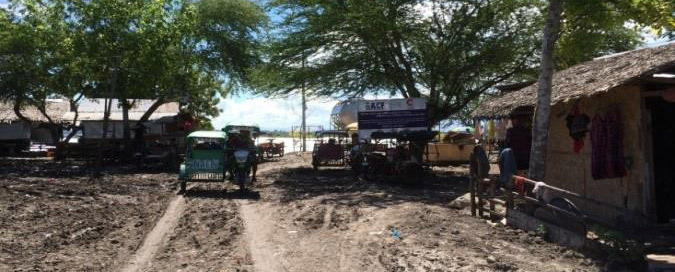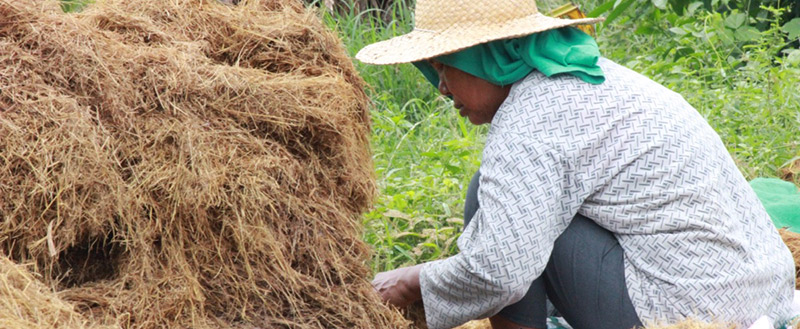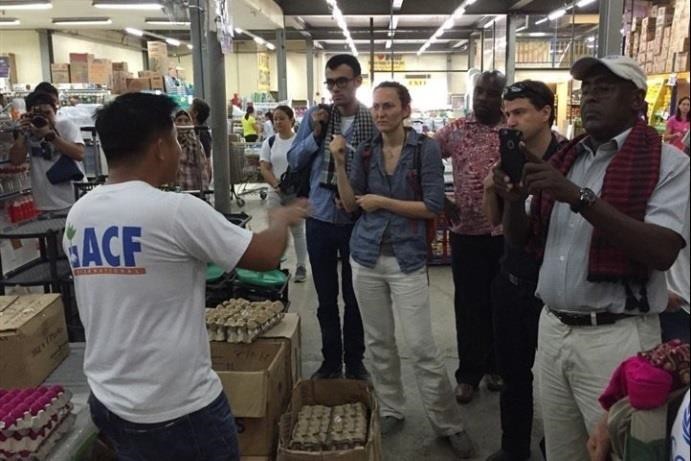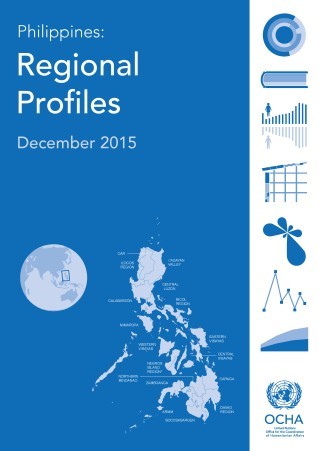
Targeted aid following Typhoon Koppu
Mitigating further deterioration in food security, health and malnutrition
The United Nations and partners are supporting the government to mitigate further deterioration in food security and related increase in malnutrition and vulnerability to disease among communities worst hit by Typhoon Koppu (known locally as Lando). The category-3 typhoon made landfall over Casiguran municipality of Aurora province (Region III) on 18 October. While the typhoon weakened upon landfall, its unusually slow journey brought heavy rains to central and northern Luzon that triggered widespread flooding, flash floods and landslides, displacing over 1 million people at the height of the disaster.
The joint effort will benefit at least 212,000 people in Nueva Ecija, Pampanga and Tarlac provinces in Region III and in Pangasinan province in Region I in the next five months. FAO will distribute certified rice seeds and fertilizers to small-scale, rice-farming households (about 65,000 people) devastated by typhoon flooding. WHO will provide essential health care and conduct disease surveillance.

Lessons from Typhoon Koppu response
International organisations adapting to the evolving operating environment
As the response to Typhoon Koppu shifted from relief to recovery and reconstruction, humanitarian partners reflected on their collective preparedness measures and relief operation. Several features stood out as effective mechanisms that were strengthened as a result of what had been learned from the response to Super Typhoon Haiyan (known locally as Yolanda) in November 2013.
The Philippines Humanitarian Country Team (HCT) is now regularly invited to the Government’s pre-disaster risk assessment as an observer, allowing international organisations to prepare for an approaching disaster with a greater understanding of the government’s planning scenario and preparedness actions.
The government also invited the HCT members to join their rapid damage and needs assessment and support the regional coordination hub established in Casiguran. The inclusiveness and opportunities for engagement helped HCT members to calibrate the scale and scope of international assistance to the specific context of Typhoon Koppu and in recognition of the leadership and responsibility of the government.
There were also trends that challenged practices that international organisations were accustomed to. For example, assistance by international organisations was provided on the basis of a specific or general request for support from government departments and local authorities. Some requests asked that aid be mobilised from resources already in the country – a new trend post-Typhoon Haiyan. This challenged international tools and mechanisms primarily designed for resource mobilisation from around the world and may curtail HCT’s ability to contribute to a disaster response in the future. International organisations are exploring ways forward in this changing operating environment.

Cash assistance to support Zamboanga IDPs
Over 23,000 people remain displaced more than two years after the conflict
“I was a no-read, no-write person. My son [had to] teach me how to write my own name. But now we are taught how to run a small business and the importance of keeping records of our transactions with receipts,” says Minda Amil, a 40-year-old mother of ten children from the indigenous badjao community of Zamboanga City in southern Philippines.
Minda is among some 118,000 people who lost their coastal homes to a conflict between the government forces and a faction of the Moro National Liberation Front in September 2013. Twenty-seven months later, about 24,600 people remain displaced in 12 transitional sites and temporarily-shared or rented homes across the city.
Luckily, Minda’s family was chosen as one of over 1,000 families (about 5,000 people) to receive conditional cash-transfer assistance from an international NGO, which included PhP8,000 ($170) livelihood grant and PhP4,000 ($85) food security vouchers. The programme targeted vulnerable households among the internally displaced people (IDPs) staying in transitional sites, prioritising those with pregnant or lactating mothers, single parents, malnourished children, the elderly and persons with disabilities or chronic illnesses.
Minda spent part of her livelihood grant to buy fishing materials and used the balance as start-up capital to put up a small retail store attached to her temporary shelter in Buggoc. As part of the aid programme she also participated in livelihood training at a local university. Five months into the venture, her store is still in business.
Challenges: flexibility, accountability, market access and culture
Cash has become an increasingly popular modality of humanitarian response that complements traditional in-kind assistance. Cash-transfer programming (CTP) honours the rights of crisis-affected households to decide how to prioritise and meet their multiple needs, while stimulating local markets. In the Philippines, a country uniquely conducive to cash, CTP has been part of emergency response since 2009.
However, striking a good balance between the flexibility of cash assistance and measures to monitor impact can be challenging. For the food security component of the CTP, the displaced families were required to buy groceries from a specified store in the city and present their receipts to the aid agency. This in turn limited the range of food items and prices available to them. “If there was more leeway, we could have spent the cash to buy root crops, dried fish and salt," said Musila Asiral, a mother of three children who is staying in Buggoc transitional site.
Uneven access to markets and culturally-specific needs of beneficiaries adds to the complexities of CTP in Zamboanga. According to Zarah Bazari, a mother of four children who lives in Mampang-2 transitional site, the cash-transfer programme has limited impact because the distance to the city centre keeps the displaced community isolated from their desired livelihoods. She laments that, while more than a few international and local aid agencies provided skills training and financial assistance to the IDPs in Mampang to restore livelihoods, new enterprises were mostly not sustainable and “went bankrupt.”
Sabtiya Utusayam and Monang Pason, two middle-aged women in Mampang, echoed Bazari’s concerns. When they received cash grants, Sabtiya joined her capital with those of four other women to start a barter business, while Monang invested in opening a small retail store. “We woke up the next day only to find our neighbours starting a same line of business, so who would buy our goods?” “No business can take off if we start in a place foreign to us. I would prefer it if we were allowed to return [to our homes, where] I can proudly say, our choice of livelihood is earning,” shares Zarah.
Finally, for Minda and many of her fellow badjaos whose traditional lifestyle, spiritual wellbeing and livelihoods depend on the sea, sustainable solutions to their displacement must take into account the community’s attachment to the sea and culturally-sensitive recovery options.
Gender-sensitive approach to conditional cash-transfer programming
Aside from injecting cash into local communities, CTP for livelihood assistance in Zamboanga offers skills training and analyses its impact on men and women by assessing gender power relations among the recipient households. Taking part in the training and attending meetings with other women have made her more decisive in the house, says Sabtiya. As a manager of her group business, she has more time on her hands than before and also feels more independent. Sharing that her husband has been taking care of their young children and grandchildren while she works, “it is like we have switched our household chores now,” added smiling Sabtiya.
It is hoped that good practices and lessons of CTP in Zamboanga, including its gender-inclusive and gender-sensitive approach, will feed into national and international discussions to improve the effectiveness of cash-based humanitarian assistance.
Data preparedness for disasters
Government forges inter-sectoral cooperation for information management
Better data preparedness can help save lives. Information on past typhoons, earthquakes, floods and landslides, geospatial and demographic makeup of different communities, socioeconomic factors contributing to vulnerabilities such as poverty incidence and malnutrition rates, when collected and analysed together, can provide a powerful tool for decision makers in preparing for and responding to natural disasters.
As part of disaster response preparedness, information management experts of the international and national humanitarian communities – including from the inter-agency Information Management Working Group, the Emergency Response Integration Centre (ERIC) and the Strengthening Information Infrastructure for Emergency Management (SIIEM) project – in the past year worked closely with relevant government counterparts to improve the availability, quality and accessibility of Government’s relevant datasets. This effort resulted in the creation of a Government-led Information Management Technical Working Group (IM-TWG), co-led by the Department of Social Welfare and Development and the Office of Civil Defense and comprising National Disaster Risk Reduction and Management Council members. The group agreed to its terms of reference and identified the listing of common and fundamental operational datasets (CODs and FODs).
What are CODs and FODs?
CODs and FODs are baseline datasets that help the government and humanitarian organizations design and implement effective humanitarian response. According to the 2010 Inter-Agency Standing Committee (IASC) guidelines, CODs are predictable, core sets of data needed for operations and decision-making by all humanitarian actors. FODs are datasets that are relevant to multiple sector operations and complement the CODs.
Adapting the IASC guidelines, the IM-TWG defined the CODs in the Philippines as datasets containing key geospatial information to support emergency response such as administrative boundaries, transportation network and topography, and FODs as attributes and statistics attached to the CODs.
Data sharing for disaster readiness
The core group of the IM-TWG, in which OCHA represents the inter-agency IM Working Group, is working with relevant government agencies to identify, harmonise and update the country’s CODs. For example, four government agencies – the National Mapping and Resource Information Authority, the Philippine Statistics Authority, the Department of Interior and Local Government and the Land Management Bureau – were consulted regarding the most updated level-4 boundary data, which determine barangay (the smallest administrative unit in the Philippines) borders. While time-consuming and labour-intensive, these consultative processes are essential in facilitating information sharing to improve the overall quality of data and to reduce redundancy and duplication of work in the long term.
Among the key objectives of the IM-TWG is to create a common platform where the CODs and FODs are defined, updated and made accessible. The group through this initiative aims to help promote the efficiency and transparency of the Government’s disaster preparedness and response efforts.
In brief
Philippines regional profiles launched
Regional profiles of the Philippines, one-page snapshots featuring geographic and demographic data of the country and all of its 17 regions, were published by the OCHA country office on 10 December as part of humanitarian data preparedness. As a consolidation of information housed in various government agencies, these profiles provide a concise reference for operational planning and analysis for disaster preparedness and response. Each snapshot contains a map and visual representations of demography, poverty and human development, disaster statistics and sectoral data on nutrition, water, sanitation and hygiene, health, livelihood, education and shelter.
